Schedule
Coconut Crop Schedule
| Product Name | Fertilizers | ||||||||||
|---|---|---|---|---|---|---|---|---|---|---|---|
| PROM/ Organic Fertilizer |
Poornima Kit | NPK Grow Caps |
Azoss/Azoto | Potash Grow | Humigrow Nano Powder |
Alp | Sonha-Bihan | Amavasya Kit | IBP-Kit | ||
| Nitrogen Fixing Bacteria | Potash Mobilizing Bacteria | Humic Acid | Chelated Multi-micronutrient |
PGP/PGR | |||||||
| Land Reparation | month 0 | ||||||||||
| Soil Treatment | month 0 | 25 kg | |||||||||
| Germination | month 1 | 1 Kit | |||||||||
| Vegetative Growth | month 2 | 1 Caps | 1 Caps | 1 Caps | 120gm | ||||||
| month 3 | |||||||||||
| month 4 | 1 Kit | ||||||||||
| month 5 | |||||||||||
| month 6 | 25 kg | 1 Caps | 1 Caps | 2 Caps | 120gm | ||||||
| month 7 | 1 Kit | ||||||||||
| month 8 | 1 Kit | ||||||||||
| month 9 | 1 kit | ||||||||||
| month 10 | 1 Caps | 1 Caps | 1 Caps | 120gm | |||||||
| month 11 | 500gm | ||||||||||
| month 12 | 1 Kit | ||||||||||
| Flowering/ Fruiting | 500gm | 500gm | |||||||||
| Harvesting | |||||||||||
| Total Quantity | 100 kg | 3 Kit | 3 Caps | 3 Caps | 4 Caps | 360gm | 1kg | 500gm | 1 Kit | 2 Kit | |
| Broadcast | |
| Top Dressing | |
| Basal Dressing | |
| Soil Application | |
| Spray | |
| * | Optional |
NOTE: For the first year donot immidietaly substitute 100% chemical fertilizer with the SIESTO GREEN products, as the soil is used to chemical fertilizer, it may affect the output. So the best way to substitute is by reducing 50% of chemical input in the first year, 25% the following 2nd year, & then another 10% by the 3rd year. After the 3rd year use synthetic fertilizer / inorganic fertilizer if their is a requirement depending on the soil health.
CROP SCHEDULE FOR PALM
Sr. No.
Treatment / Application
Product
Dose / Acre
APPLICATION
Management
1
Vegetative – Dissolve in 20 to 200 ltr. of water as required for 1 acre of land and apply through Drip Irrigation or drench.
POORNIMA KIT
1 KIT
Apply it in month 4, month 8, and month 12
It is a balanced form of nutrients that includes NPK, Zinc, Cropforce NP, Humigrow NP, and Mycorrhiza NP
2
Vegetative – Dissolve in 20 to 200 ltr. of water as required for 1 acre of land and apply through Drip Irrigation or drench.
Azoss/Azoto + Potash grow Caps + Humigrow Caps
1cap + 1cap + 120gm
Apply it in month 2, 6 and 10
These are the bacteria for Nitrogen and Potash
3
Vegetative – Dissolve in 20 to 200 ltr. of water as required for 1 acre of land and apply through Drip Irrigation or drench.
NPK Caps + Humigrow NP
2 Caps + 120gm
Apply it in month 2, 6 and 10
It is a balanced form of nutrients that includes NPK caps and Humigrow NP
4
Fruiting – Mix it in the required amount of water and apply through Drip irrigation or Drench near the plants.
ALP + Sonhabihan
500gm + 500gm
Apply it in month 11 and at the time of flowering & fruiting
It consists of essential Micronutrient and PGP that helps in Growth, Fruit set, and the quality of the produce.
5
Vegetative and Flowering/ Fruiting – Mix all with the required amount of water and apply through foliar spray or drenching as per infestation of insect.
Amavasya kit
1 KIT
Apply it in month 7
It is a balanced form of insecticides which include Traps, lifeline, Bt, Acarida, and Meta capsules.
6
Soil Treatment – Dissolve in 20lit. to 200lit. of water as per requirement for 1 acre of land and apply through drip irrigation or drench.
IBP KIT
1 KIT
Apply it in month 1 and 9
It prevents soil-borne diseases and nematodes. Apply as per the soil health and soil-borne diseases.
Repeat these steps every year
PEST ATTACKS, BACTERIAL, OR FUNGAL MANAGEMENT
PEST / BACTERIAL / FUNGAL
IDENTIFICATION IN CROP
SYMPTOMS
SUGGESTED PRODUCT
Rhinoceros Beetle
 Holes in central spindle. Holes with chewed fibre sticking out in central spindle. Triangular cuts on leaves.
Meta + BT + Traps
Palm Leaf Skeletonizer
Holes in central spindle. Holes with chewed fibre sticking out in central spindle. Triangular cuts on leaves.
Meta + BT + Traps
Palm Leaf Skeletonizer
 It is a small caterpillar that feeds in large numbers on both surfaces of palm leaves. It eats away the palm leaf between the veins or the ribs producing a dark tube structure that looks like a leaf skeleton.
Traps + Indofa + BT
Mealybugs
It is a small caterpillar that feeds in large numbers on both surfaces of palm leaves. It eats away the palm leaf between the veins or the ribs producing a dark tube structure that looks like a leaf skeleton.
Traps + Indofa + BT
Mealybugs
 They attach themselves to the plant producing a powdery wax that is used for protection, hence the name mealybug. One mealybug will not hurt your plant, but they multiply quickly creating large colonies.
Traps + Lifeline
Leaf Spots
They attach themselves to the plant producing a powdery wax that is used for protection, hence the name mealybug. One mealybug will not hurt your plant, but they multiply quickly creating large colonies.
Traps + Lifeline
Leaf Spots
 It is caused by a variety of fungi and some bacteria on many trees. Leaf spots can be circular to elongated, brown, and possibly oily in appearance.
Indofa
False Smut
It is caused by a variety of fungi and some bacteria on many trees. Leaf spots can be circular to elongated, brown, and possibly oily in appearance.
Indofa
False Smut
 This disease is most common in areas of high humidity. Small, black, wart-like bodies are seen, often with yellow filaments protruding from the middle of the raised spots.
Bacillus + BT
Sooty Mold
This disease is most common in areas of high humidity. Small, black, wart-like bodies are seen, often with yellow filaments protruding from the middle of the raised spots.
Bacillus + BT
Sooty Mold
 It forms a black covering on the leaves. It’s always associated with an infestation of insects.
Indofa + Bacillus + Lifeline
Bud Rot
It forms a black covering on the leaves. It’s always associated with an infestation of insects.
Indofa + Bacillus + Lifeline
Bud Rot
 Bud rot tends to occur after a tropical storm or periods of excessive rain, and bacterial bud rot tends to occur after the bud has been damaged by cold weather.
Indofa + Bacillus
Ganoderma Butt Rot
Bud rot tends to occur after a tropical storm or periods of excessive rain, and bacterial bud rot tends to occur after the bud has been damaged by cold weather.
Indofa + Bacillus
Ganoderma Butt Rot
 It usually attacks older palm trees that are 15 or more years old. The first symptom of infection is the withering and drooping of older fronds.
Indofa + Bacillus
Fusarium Wilt
It usually attacks older palm trees that are 15 or more years old. The first symptom of infection is the withering and drooping of older fronds.
Indofa + Bacillus
Fusarium Wilt
 On infected palms, the leaflets on only one side of the leaf stem of the oldest leaves start to turn brown and then die. The fronds develop a reddish or dark brown stripe along the leaf stem.
Indofa + BT + Lifeline
Bacterial Bud Rot
On infected palms, the leaflets on only one side of the leaf stem of the oldest leaves start to turn brown and then die. The fronds develop a reddish or dark brown stripe along the leaf stem.
Indofa + BT + Lifeline
Bacterial Bud Rot
 Affected leaf spears often will pull easily from the bud. A foul odor can also be present. This disease usually affects cold-damaged palms.
Indofa + Bacillus
Affected leaf spears often will pull easily from the bud. A foul odor can also be present. This disease usually affects cold-damaged palms.
Indofa + Bacillus
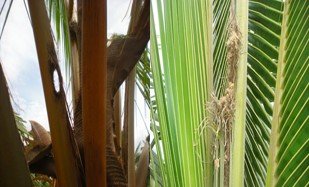 Holes in central spindle. Holes with chewed fibre sticking out in central spindle. Triangular cuts on leaves.
Meta + BT + Traps
Palm Leaf Skeletonizer
Holes in central spindle. Holes with chewed fibre sticking out in central spindle. Triangular cuts on leaves.
Meta + BT + Traps
Palm Leaf Skeletonizer
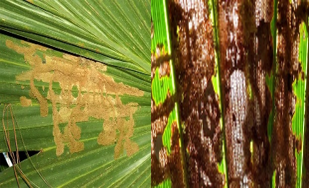 It is a small caterpillar that feeds in large numbers on both surfaces of palm leaves. It eats away the palm leaf between the veins or the ribs producing a dark tube structure that looks like a leaf skeleton.
Traps + Indofa + BT
Mealybugs
It is a small caterpillar that feeds in large numbers on both surfaces of palm leaves. It eats away the palm leaf between the veins or the ribs producing a dark tube structure that looks like a leaf skeleton.
Traps + Indofa + BT
Mealybugs
 They attach themselves to the plant producing a powdery wax that is used for protection, hence the name mealybug. One mealybug will not hurt your plant, but they multiply quickly creating large colonies.
Traps + Lifeline
Leaf Spots
They attach themselves to the plant producing a powdery wax that is used for protection, hence the name mealybug. One mealybug will not hurt your plant, but they multiply quickly creating large colonies.
Traps + Lifeline
Leaf Spots
 It is caused by a variety of fungi and some bacteria on many trees. Leaf spots can be circular to elongated, brown, and possibly oily in appearance.
Indofa
False Smut
It is caused by a variety of fungi and some bacteria on many trees. Leaf spots can be circular to elongated, brown, and possibly oily in appearance.
Indofa
False Smut
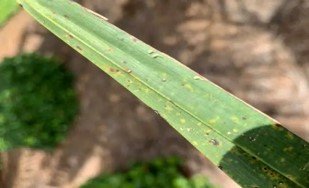 This disease is most common in areas of high humidity. Small, black, wart-like bodies are seen, often with yellow filaments protruding from the middle of the raised spots.
Bacillus + BT
Sooty Mold
This disease is most common in areas of high humidity. Small, black, wart-like bodies are seen, often with yellow filaments protruding from the middle of the raised spots.
Bacillus + BT
Sooty Mold
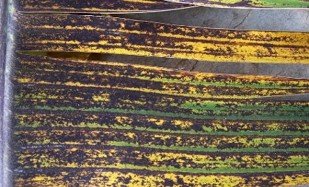 It forms a black covering on the leaves. It’s always associated with an infestation of insects.
Indofa + Bacillus + Lifeline
Bud Rot
It forms a black covering on the leaves. It’s always associated with an infestation of insects.
Indofa + Bacillus + Lifeline
Bud Rot
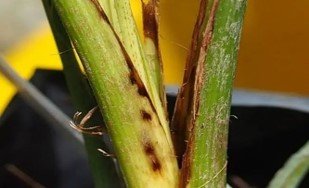 Bud rot tends to occur after a tropical storm or periods of excessive rain, and bacterial bud rot tends to occur after the bud has been damaged by cold weather.
Indofa + Bacillus
Ganoderma Butt Rot
Bud rot tends to occur after a tropical storm or periods of excessive rain, and bacterial bud rot tends to occur after the bud has been damaged by cold weather.
Indofa + Bacillus
Ganoderma Butt Rot
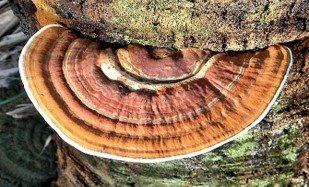 It usually attacks older palm trees that are 15 or more years old. The first symptom of infection is the withering and drooping of older fronds.
Indofa + Bacillus
Fusarium Wilt
It usually attacks older palm trees that are 15 or more years old. The first symptom of infection is the withering and drooping of older fronds.
Indofa + Bacillus
Fusarium Wilt
 On infected palms, the leaflets on only one side of the leaf stem of the oldest leaves start to turn brown and then die. The fronds develop a reddish or dark brown stripe along the leaf stem.
Indofa + BT + Lifeline
Bacterial Bud Rot
On infected palms, the leaflets on only one side of the leaf stem of the oldest leaves start to turn brown and then die. The fronds develop a reddish or dark brown stripe along the leaf stem.
Indofa + BT + Lifeline
Bacterial Bud Rot
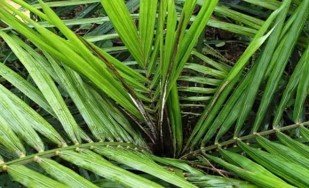 Affected leaf spears often will pull easily from the bud. A foul odor can also be present. This disease usually affects cold-damaged palms.
Indofa + Bacillus
Affected leaf spears often will pull easily from the bud. A foul odor can also be present. This disease usually affects cold-damaged palms.
Indofa + Bacillus
NUTRITION DEFICIENCY
NUTRIENT
IDENTIFICATION
SYMPTOMS
SUGGESTED PRODUCT
Potassium
 Early symptoms are translucent yellow to orange spots that sometimes are accompanied by black spots of dead tissue.
Potash Grow Caps
Nitrogen
Early symptoms are translucent yellow to orange spots that sometimes are accompanied by black spots of dead tissue.
Potash Grow Caps
Nitrogen
 Symptoms of nitrogen deficiency are overall light green color of the leaves and decreased growth of the palm.
Azoss / Azoto
Iron
Symptoms of nitrogen deficiency are overall light green color of the leaves and decreased growth of the palm.
Azoss / Azoto
Iron
 Most likely a result of poorly aerated soil, root damage, or improper planting depth rather than a lack of Fe in the soil.
ALP
Manganese
Most likely a result of poorly aerated soil, root damage, or improper planting depth rather than a lack of Fe in the soil.
ALP
Manganese
 It shows up on acid-loving palms grown in alkaline soils. This problem is caused by insufficient Mn in the soil or by high pH (above pH 6.5). Other factors like poor drainage or too much water can also play a role.
ALP
It shows up on acid-loving palms grown in alkaline soils. This problem is caused by insufficient Mn in the soil or by high pH (above pH 6.5). Other factors like poor drainage or too much water can also play a role.
ALP
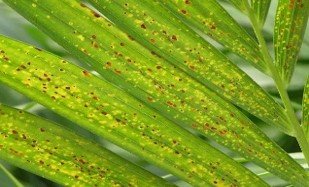 Early symptoms are translucent yellow to orange spots that sometimes are accompanied by black spots of dead tissue.
Potash Grow Caps
Nitrogen
Early symptoms are translucent yellow to orange spots that sometimes are accompanied by black spots of dead tissue.
Potash Grow Caps
Nitrogen
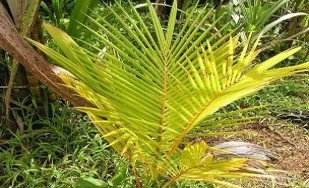 Symptoms of nitrogen deficiency are overall light green color of the leaves and decreased growth of the palm.
Azoss / Azoto
Iron
Symptoms of nitrogen deficiency are overall light green color of the leaves and decreased growth of the palm.
Azoss / Azoto
Iron
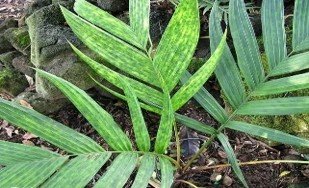 Most likely a result of poorly aerated soil, root damage, or improper planting depth rather than a lack of Fe in the soil.
ALP
Manganese
Most likely a result of poorly aerated soil, root damage, or improper planting depth rather than a lack of Fe in the soil.
ALP
Manganese
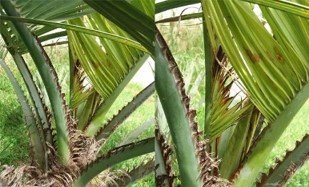 It shows up on acid-loving palms grown in alkaline soils. This problem is caused by insufficient Mn in the soil or by high pH (above pH 6.5). Other factors like poor drainage or too much water can also play a role.
ALP
It shows up on acid-loving palms grown in alkaline soils. This problem is caused by insufficient Mn in the soil or by high pH (above pH 6.5). Other factors like poor drainage or too much water can also play a role.
ALP


